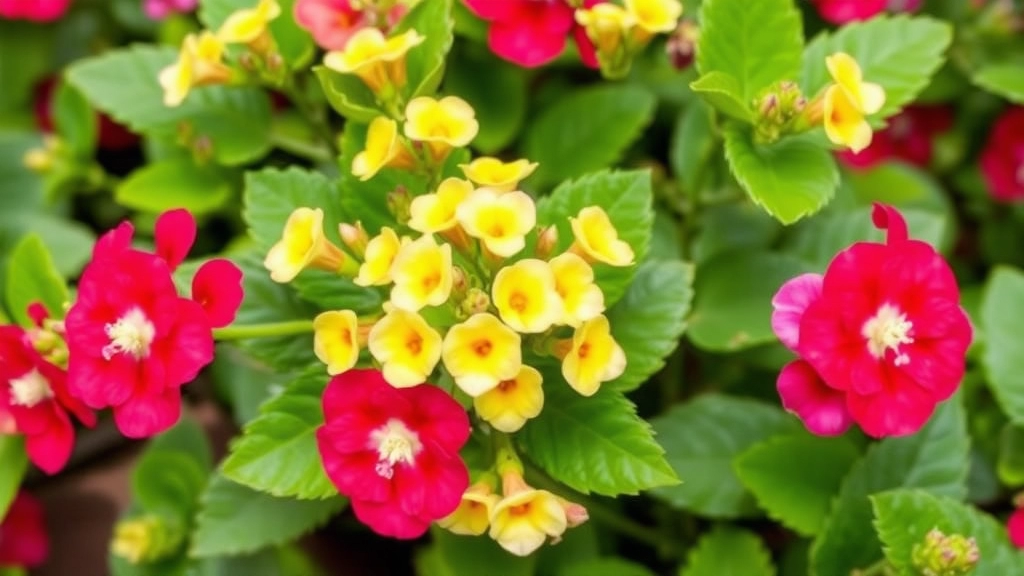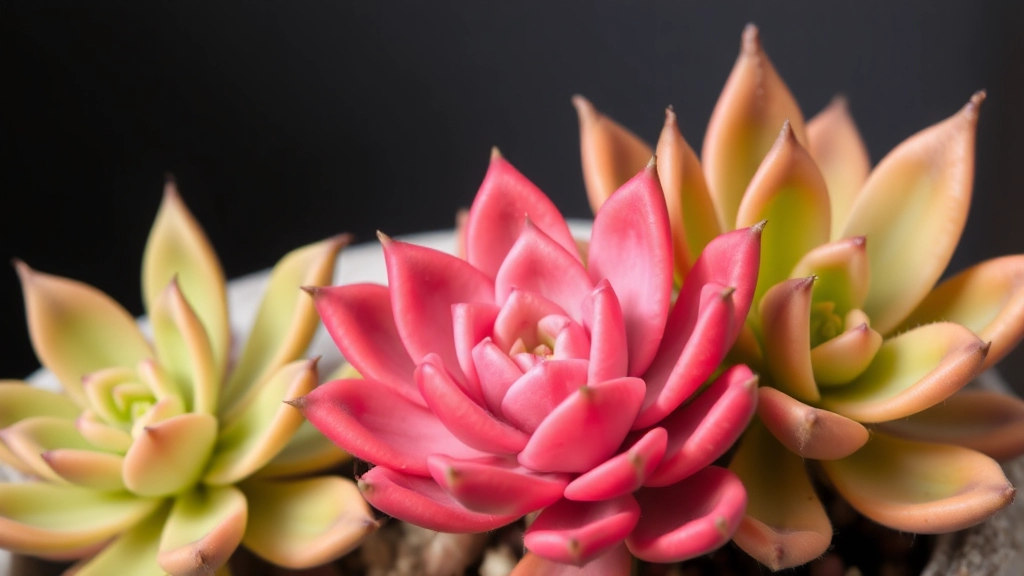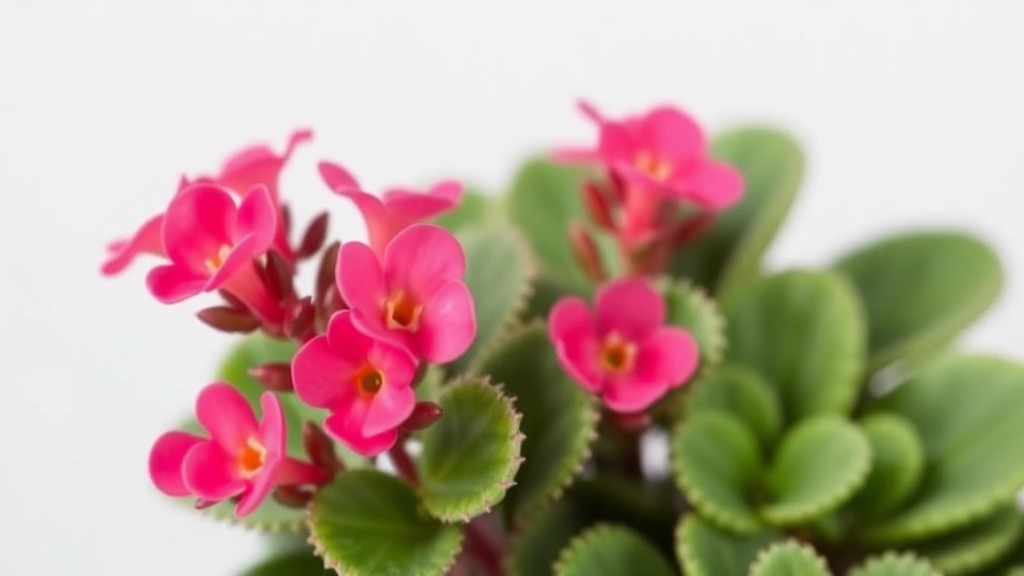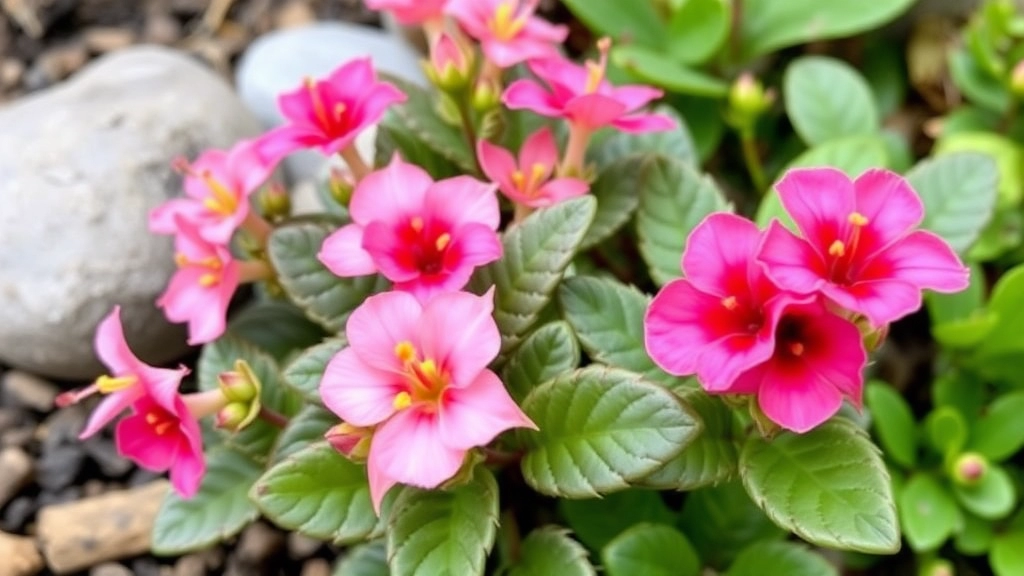Searching for Kalanchoe Species Photos?
You’ve come to the right place. As a plant enthusiast, I know how crucial it is to see the variety of Kalanchoe species before deciding which ones to grow. From their vibrant flowers to unique leaf structures, Kalanchoes offer a visual feast that’s both captivating and informative.
What to Expect in This Guide
In this guide, you’ll find a collection of stunning Kalanchoe species photos, each showcasing the distinct characteristics that make these plants so special. Whether you’re a beginner looking for easy-to-grow options or an experienced gardener seeking rare varieties, these images will help you identify and appreciate the diversity of Kalanchoes.
Dive In and Discover
the beauty of these adaptable and visually appealing plants.
Overview of Kalanchoe Species: Diversity and Visual Appeal
When considering the world of succulents, Kalanchoe species stand out for their remarkable diversity and visual appeal.
These plants are not only easy to care for but also bring vibrant colours and unique textures to any space.
The Allure of Kalanchoe
- Diverse Species: Kalanchoe comprises numerous species, each with its own distinctive features.
- Visual Appeal: From striking flowers to unique leaf structures, these plants can transform a dull corner into a lively display.
Many gardeners wonder how to choose the right Kalanchoe for their needs.
Kalanchoes are known for their resilience, making them suitable for both novice and seasoned gardeners.
Why Choose Kalanchoe?
- Variety: With options ranging from flowering types to those with intriguing foliage, there’s a Kalanchoe for everyone.
- Low Maintenance: They thrive in various conditions, requiring minimal care.
For those interested in specific varieties, the Kalanchoe Tomentosa varieties offer unique textures and colors. Additionally, understanding the key features of different Kalanchoe species can help in making an informed choice for your garden.
Popular Flowering Kalanchoes and Their Distinct Features

If you’re wondering which flowering Kalanchoes can brighten up your space, you’re in for a treat. These plants are not just pretty faces; they have unique traits that make them stand out in any garden or indoor setting.
Kalanchoe Blossfeldiana
First up is the Kalanchoe Blossfeldiana, often called the Flaming Katy.
- Flowers: It boasts vibrant clusters of small flowers in shades like red, pink, yellow, and white.
- Care: This beauty thrives in bright light but can tolerate some shade.
- Blooming: Expect blooms to last for several weeks, making it a fantastic choice for a splash of colour.
Kalanchoe Tomentosa
Next, let’s chat about the Kalanchoe Tomentosa, also known as the Panda Plant.
- Leaves: Its fuzzy, grey-green leaves are edged with a reddish hue, giving it a unique look.
- Flowers: When it blooms, you’ll see delicate yellow flowers that add a lovely contrast.
- Care: This one loves bright, indirect light and is quite forgiving if you forget to water it occasionally.
Kalanchoe Luciae
Then there’s the Kalanchoe Luciae, or the Paddle Plant.
- Shape: Its large, flat leaves resemble paddles, and they can turn a stunning red when exposed to bright sunlight.
- Flowers: It produces tall flower spikes with yellow blooms, which are a sight to behold.
- Care: It enjoys a sunny spot and well-draining soil, perfect for those who want a low-maintenance option.
Kalanchoe Marmorata
Finally, let’s not overlook the Kalanchoe Marmorata, known as the Mother of Thousands.
- Leaves: Its striking marbled leaves are a conversation starter, with a pattern that’s simply eye-catching.
- Flowers: When it flowers, you’ll see clusters of small, tubular blooms that attract pollinators.
- Care: This one thrives in bright light and needs minimal watering, making it perfect for busy plant parents.
These popular flowering Kalanchoes offer not just beauty but also a range of features that cater to different gardening styles and preferences. Whether you’re drawn to vibrant blooms or unique leaf structures, there’s a Kalanchoe for everyone.
Uncommon Kalanchoe Varieties: Rare and Exotic Species
As we explore the captivating world of Kalanchoe, it’s essential to highlight some of the uncommon varieties that can truly elevate your collection. These rare and exotic species not only add uniqueness to your garden but also spark curiosity and conversation.
What Makes Kalanchoe Exotic?
Rare Kalanchoe species often possess unusual features, such as unique leaf shapes, vibrant colours, or distinctive growth habits. Here are a few standout varieties to consider:
- Kalanchoe thyrsiflora: Also known as the “Paddle Plant,” this succulent features thick, paddle-like leaves that can turn a stunning red under the right conditions. Its striking appearance makes it a favourite among collectors. Learn more about its care in our Kalanchoe Paddle Plant Flower Care Guide.
- Kalanchoe luciae: Often referred to as “Flapjack,” this succulent has fleshy, oval leaves that grow in a rosette pattern. The leaves can develop a beautiful blush colour when exposed to sunlight.
- Kalanchoe beharensis: Known as the “Elephant Bush,” this species showcases large, fuzzy leaves that resemble elephant ears. It’s a conversation starter for any plant enthusiast. For detailed care instructions, visit our Kalanchoe Beharensis Variegata Care Guide.
- Kalanchoe marmorata: Commonly called “Pencil Plant,” this variety features mottled leaves that create a stunning visual effect. Its unique patterns make it a true gem in any collection.
Why Collect Rare Kalanchoes?
- Visual Appeal: Their distinct aesthetics can enhance any garden or indoor space.
- Conversation Starters: Rare species often pique interest and invite discussions among fellow plant lovers.
- Personal Satisfaction: Cultivating uncommon varieties can be a rewarding challenge for dedicated gardeners.
If you’re eager to expand your Kalanchoe collection with these rare finds, keep an eye out at local nurseries or online specialty shops.
Succulent Kalanchoes with Unique Leaf Structures

When exploring the captivating world of Kalanchoe, the unique leaf structures of certain species truly stand out. These succulents not only add visual interest but also serve practical purposes in their native habitats.
Diverse Leaf Shapes and Textures
Kalanchoes exhibit a range of leaf shapes and textures that can intrigue any plant enthusiast. Here are some notable examples:
- Kalanchoe luciae: Known as the “Paddle Plant,” its thick, paddle-like leaves are often tinged with a stunning red edge, making it a striking addition to any collection.
- Kalanchoe tomentosa: Commonly referred to as “Panda Plant,” this species features fuzzy, velvety leaves adorned with brown spots, giving it a whimsical appearance.
- Kalanchoe beharensis: Often called “Felt Plant,” its large, triangular leaves are covered in a soft, felt-like texture, providing a unique sensory experience.
- Kalanchoe marmorata: Known for its marbled leaves, this species showcases a stunning pattern that adds depth and character to any garden.
These unique leaf structures not only serve aesthetic purposes but also aid in water retention, making them resilient in arid conditions.
Why Leaf Structure Matters
Understanding the significance of leaf structure can enhance your gardening experience. Here are a few reasons:
- Water Conservation: Succulent leaves store water, allowing the plant to thrive in dry conditions.
- Sun Protection: Some leaf shapes reflect sunlight, helping the plant avoid sunburn.
- Pest Resistance: Textured leaves can deter pests, reducing the need for chemical interventions.
Fuzzy and Textured Kalanchoe Types: A Visual Guide
When exploring the diverse world of Kalanchoe species, many enthusiasts find themselves captivated by the fuzzy and textured varieties. These unique characteristics not only enhance their visual appeal but also invite curiosity about their care and cultivation.
The Allure of Fuzzy Kalanchoes
Fuzzy Kalanchoes, such as Kalanchoe tomentosa, often known as “Panda Plant,” are adored for their velvety leaves. Their soft texture adds a tactile element to any garden or indoor space. Here’s why they stand out:
- Visual Interest: The contrasting textures of fuzzy leaves can create a striking visual in your plant collection.
- Unique Features: Many fuzzy Kalanchoes have distinct markings or colours, enhancing their aesthetic appeal.
Popular Textured Varieties
- Kalanchoe tomentosa (Panda Plant)
- Soft, fuzzy leaves with distinctive brown edges.
- Great for indoor settings due to its low light requirements. Learn more in our Kalanchoe tomentosa care guide.
- Kalanchoe beharensis (Felt Plant)
- Large, felt-like leaves that can grow quite large.
- Ideal for outdoor gardens in warmer climates. For detailed care instructions, visit our Kalanchoe beharensis care guide.
- Kalanchoe luciae (Paddle Plant)
- Thick, paddle-shaped leaves with a slight fuzziness.
- Known for its vibrant red edges when exposed to sunlight.
Caring for Fuzzy Kalanchoes
Caring for these textured beauties can be straightforward if you keep a few key points in mind:
- Light: Most fuzzy Kalanchoes thrive in bright, indirect sunlight.
- Watering: Allow the soil to dry out between waterings to prevent root rot.
- Temperature: They prefer warmer temperatures, ideally above 15°C.
The appeal of fuzzy and textured Kalanchoes can elevate your garden’s charm, making them a delightful choice for plant lovers.
Best Indoor and Outdoor Kalanchoes for Home Gardens

So, you’ve got your eye on Kalanchoes for your home garden, but which ones should you choose for indoor and outdoor spaces?
Indoor Kalanchoes
Indoor Kalanchoes are perfect for adding a splash of colour to your living space. Here are some top picks:
- Kalanchoe Blossfeldiana
A classic choice, this one blooms with vibrant flowers in shades of red, pink, and yellow. It’s low-maintenance and thrives in bright, indirect light. - Kalanchoe Tomentosa (Panda Plant)
With its fuzzy leaves, this succulent is not just cute but also easy to care for. It prefers bright light and can handle a bit of neglect. - Kalanchoe Luciae (Flapjack Plant)
Its large, flat leaves are stunning and can change colour with the seasons. It’s a real eye-catcher for any indoor setting.
Outdoor Kalanchoes
When it comes to outdoor gardens, some Kalanchoes can really shine in the sunlight. Here are some excellent choices:
- Kalanchoe Thyrsiflora (Mother of Thousands)
This one is hardy and can handle full sun. It produces clusters of small flowers that attract pollinators. - Kalanchoe Fedtschenkoi (Paddle Plant)
Known for its striking leaf shape, it’s drought-tolerant and loves bright light. It’s a great option for rock gardens. - Kalanchoe beharensis (Elephant Bush)
This unique variety can grow quite tall and makes a fantastic statement piece in any garden. It thrives in warm, sunny spots.
Tips for Choosing the Right Kalanchoe
- Consider your space: Think about light availability and space size.
- Maintenance level: Choose varieties that match your gardening style—some need more care than others.
- Aesthetic appeal: Pick Kalanchoes that complement your existing plants and décor.
Easy-to-Grow Kalanchoe Species for Beginners
Are you new to gardening and considering Kalanchoes? You’re not alone. Many budding gardeners seek low-maintenance plants that still offer vibrant beauty.
Kalanchoes are an excellent choice for beginners, as they thrive with minimal care and can adapt to various environments. Here are some easy-to-grow Kalanchoe species that will make your gardening journey enjoyable and rewarding.
1. Kalanchoe Blossfeldiana
- Visual Appeal: Known for its bright, clustered flowers.
- Care Level: Very forgiving; just ensure it gets plenty of sunlight.
- Watering: Allow the soil to dry out between waterings.
2. Kalanchoe Tomentosa (Panda Plant)
- Unique Feature: Fuzzy leaves with a soft texture.
- Care Level: Thrives in bright light and requires minimal watering.
- Watering: Water sparingly; overwatering can lead to root rot.
3. Kalanchoe Luciae (Flapjack Plant)
- Visual Appeal: Stunning, paddle-shaped leaves that turn red in sunlight.
- Care Level: Very easy to maintain; perfect for beginners.
- Watering: Water when the soil is dry to the touch.
4. Kalanchoe Thyrsiflora
- Unique Feature: Tall flower spikes with vibrant blooms.
- Care Level: Requires little attention; great for busy lifestyles.
- Watering: Water infrequently, allowing the soil to dry out.
5. Kalanchoe Fedtschenkoi
- Visual Appeal: Beautiful, scalloped leaves with a hint of blue.
- Care Level: Adapts well to various conditions.
- Watering: Similar to others; avoid soggy soil.
These Kalanchoe species not only add colour to your space but also offer a sense of accomplishment as you watch them thrive with minimal effort. For more detailed care tips, check out our Ultimate Guide to Caring for Kalanchoe Succulents and our Indoor vs. Outdoor Care Guide for Kalanchoe Blossfeldiana.
Care Tips for Different Kalanchoe Species Based on Region

When it comes to caring for Kalanchoe, the region you’re in can make a huge difference. You might be wondering, “How do I keep my Kalanchoe thriving in my climate?”
Let’s break it down by region, so you can give your plants the best chance to flourish.
1. Tropical and Subtropical Regions
- Light: Kalanchoes love bright, indirect sunlight.
- Watering: Water when the top inch of soil feels dry. Avoid soggy soil!
- Humidity: These plants enjoy a bit of humidity but can adapt.
- Fertiliser: Feed with a balanced fertiliser every month during the growing season.
2. Temperate Regions
- Light: Make sure they get at least 6 hours of sunlight daily.
- Watering: In winter, reduce watering as they enter dormancy.
- Temperature: Protect from frost; bring them indoors if it’s too cold.
- Soil: Use well-draining soil to prevent root rot.
3. Desert Regions
- Light: Full sun is a must! They thrive in bright conditions.
- Watering: Water less frequently; once every two weeks is often enough.
- Soil: A gritty, sandy mix is ideal for drainage.
- Fertiliser: Use a diluted cactus fertiliser during the growing season.
4. Cold Climates
- Light: Place them near a sunny window for maximum light.
- Watering: Keep the soil just moist; overwatering is a common mistake.
- Temperature: Keep them indoors during winter; they don’t like the cold.
- Humidity: If your home is dry, consider misting occasionally.
General Tips for All Regions
- Pest Control: Keep an eye out for mealybugs and aphids. A gentle wipe with soapy water can do wonders.
- Repotting: Every couple of years, give them fresh soil to keep them happy.
Flowering Kalanchoes
- Kalanchoe blossfeldiana: Known for its bright clusters of flowers, this species is a favourite for indoor displays. For more on how to care for this stunning plant, check out our Optimal Care for Kalanchoe Blossfeldiana guide.
- Kalanchoe luciae: Often called the “Flapjack” plant, it features striking red-edged leaves and occasional blooms. Learn how to grow and maintain this beautiful plant in our Kalanchoe Luciae Care Guide.
Uncommon Varieties
- Kalanchoe thyrsiflora: This rare beauty boasts large, flat leaves and produces a unique flower spike.
- Kalanchoe beharensis: Also known as the “Elephant Ear,” its textured leaves add an exotic touch to any collection. For detailed care tips, visit our Elephant Ear Kalanchoe Guide.
Succulent Kalanchoes
- Kalanchoe tomentosa: With its fuzzy leaves, this species is a tactile delight and can be a conversation starter.
- Kalanchoe ‘Pink Butterflies’: This hybrid features unique, butterfly-shaped leaves that are a feast for the eyes. Discover how to propagate this plant in our Step-by-Step Propagation Guide.
Fuzzy and Textured Types
- Kalanchoe marmorata: Its mottled leaves give an artistic flair, making it a standout choice for any garden.
- Kalanchoe ‘Chocolate Soldier’: The velvety texture and rich colour make this a must-have for collectors.
Best Choices for Gardens
- Kalanchoe fedtschenkoi: Ideal for outdoor gardens, this species thrives in various conditions and produces lovely blooms.
- Kalanchoe pinnata: A resilient choice for beginners, it flourishes in both indoor and outdoor settings.
FAQs on Kalanchoe Species Photos
What are some popular flowering Kalanchoe species?
Some popular flowering Kalanchoe species include Kalanchoe Blossfeldiana (Flaming Katy), Kalanchoe Tomentosa (Panda Plant), Kalanchoe Luciae (Paddle Plant), and Kalanchoe Marmorata (Mother of Thousands).
What makes Kalanchoe Blossfeldiana unique?
Kalanchoe Blossfeldiana is known for its vibrant clusters of small flowers in shades like red, pink, yellow, and white. It thrives in bright light and its blooms can last for several weeks.
How do I care for a Kalanchoe Tomentosa?
Kalanchoe Tomentosa, or Panda Plant, prefers bright, indirect light and is forgiving if you occasionally forget to water it. Its fuzzy, grey-green leaves edged with a reddish hue make it unique.
What are the distinctive features of Kalanchoe Luciae?
Kalanchoe Luciae, also known as the Paddle Plant, has large, flat leaves that can turn a stunning red when exposed to bright sunlight. It produces tall flower spikes with yellow blooms and enjoys a sunny spot with well-draining soil.
Which Kalanchoe species have unique leaf structures?
Species like Kalanchoe Luciae (Paddle Plant), Kalanchoe Tomentosa (Panda Plant), Kalanchoe Beharensis (Felt Plant), and Kalanchoe Marmorata (Mother of Thousands) are known for their unique leaf structures.
Why is leaf structure important in Kalanchoes?
Leaf structure in Kalanchoes aids in water conservation, sun protection, and pest resistance, making these plants resilient in various conditions.
What are the best Kalanchoes for indoor gardens?
For indoor gardens, consider Kalanchoe Blossfeldiana, Kalanchoe Tomentosa (Panda Plant), and Kalanchoe Luciae (Flapjack Plant) for their vibrant colours and ease of care.
Which Kalanchoes are suitable for outdoor gardens?
For outdoor gardens, Kalanchoe Thyrsiflora (Mother of Thousands), Kalanchoe Fedtschenkoi (Paddle Plant), and Kalanchoe Beharensis (Elephant Bush) are excellent choices due to their hardiness and ability to handle full sun.
How do I care for Kalanchoes in tropical and subtropical regions?
In tropical and subtropical regions, Kalanchoes prefer bright, indirect sunlight, moderate watering when the top inch of soil is dry, and a bit of humidity. Fertilise monthly during the growing season.
What are the care tips for Kalanchoes in temperate regions?
In temperate regions, ensure Kalanchoes get at least 6 hours of sunlight daily, reduce watering in winter, protect them from frost, and use well-draining soil to prevent root rot.
How should I care for Kalanchoes in desert regions?
In desert regions, Kalanchoes thrive in full sun, require infrequent watering (about once every two weeks), and benefit from a gritty, sandy soil mix. Use a diluted cactus fertiliser during the growing season.
What are the care guidelines for Kalanchoes in cold climates?
In cold climates, place Kalanchoes near a sunny window, keep the soil just moist, and bring them indoors during winter. Occasionally mist the plants if the indoor air is dry.
What general care tips apply to all Kalanchoe species?
General care tips include monitoring for pests like mealybugs and aphids, repotting every couple of years with fresh soil, and ensuring proper light and watering conditions based on the specific species and region.
References
-
Growing Kalanchoe Succulents
-
Kalanchoe Plant Care
-
Kalanchoe: How to Grow and Care for Kalanchoe Plants
